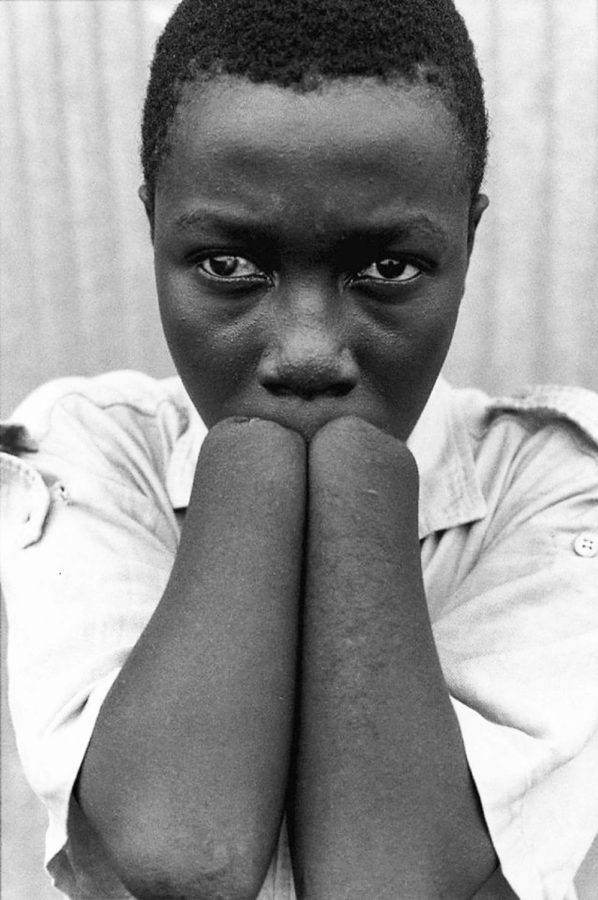TISINGER: Blood diamonds are forever
A 17-year old with hands amputated by rebels’ machetes, Waterloo camp, Sierra Leone. 1998. Photo Courtesy: UNICEF
January 14, 2009
Diamonds are forever,” “Every kiss begins with Kay” and “Love Rocks” are just a few of the slogans we have seen more and more often this holiday season. The ads have become more prominent in the past two months and often make it look like diamonds create perfect love between couples.
I have had seven friends married this year alone, and five more engaged. Having thought so much about the marriages themselves, I never really gave a thought to the diamonds — and other people — involved in the joyous occasion.
A lot of awareness involving blood diamonds arose after the 2006 movie “Blood Diamond.” The movie, although not entirely accurate, does show the trouble that comes with diamond mining and its brutal history.
Sierra Leone in Africa is the number-one diamond mining area worldwide. It has also received a lot of attention because of awful things that have happened because of the diamond wars. The diamonds are called blood diamonds, or conflict diamonds, because of the way they are mined and sold.
Rebel groups kidnap children, referred to as child soldiers, to work in the mines. Some of these children get caught by other groups and have body parts removed as punishment and to keep them from mining. The diamonds sold by these groups help to finance their insurgencies.
The Partnership Africa Canada stated on its Web site that “upwards of 50,000 [have been] killed, half the population displaced and more than two-thirds of its already severely limited infrastructure destroyed.” They continue, claiming these diamonds generate revenues of $7.5 billion annually.
Amnesty International has taken measures to educate people on just how ignorant we are about what is happening in Sierra Leone.
Its Web site, www.amnestyusa.org, states, “If nothing else, the story of Sierra Leone’s diamond war has proved unequivocally that the world ignores Africa and its problems at its peril. Events far from home often have very tangible impacts, and Sierra Leone has shown the world that there is no longer any such thing as an ‘isolated, regional conflict.’”
After taking a lot of heat from the media over its Sierra Leone mines, the De Beers diamond company openly admitted in Time Magazine to having bought conflict diamonds in the past and vowed to find alternative sources If they were going to switch sources and buy conflict-free diamonds, wouldn’t they advertise their good deeds? After the article published the De Beers Company has said not much else on the topic.
De Beers sold 85 to 90 percent of the world’s rough diamonds in the 20th century, according to Costas Arkolakis, assistant professor of economics at Yale University. Because of this, De Beers is able to decide how many are to be released to gem cutters and at what price. This raises the question: are diamonds really as rare as we believe?
In 2004, the company pleaded guilty to price fixing, tarnishing its reputation and making way for other companies to compete and lead a diamond-mine empire. This means that even if De Beers no longer sells blood diamonds, other companies might.
Celebrities are starting to be a voice for child soldiers in Africa. Kanye West’s song, “Diamonds from Sierra Leone,” is about child soldiers and how blood diamonds aren’t worth the price. His music video shows pictures of children in mines and a man proposing to a woman only for her hand to start bleeding. The end of the video urges consumers to purchase conflict-free diamonds.
Hollywood, corporations and organizations are spreading awareness about blood diamonds. All we have to do is listen. Before you put that diamond engagement ring on your wish list, ask the jeweler if they only sell conflict-free diamonds — because a marriage is forever, but so are blood diamonds.
– Sarah Tisinger is a sophomore in pre-journalism and mass communication from Bettendorf.







